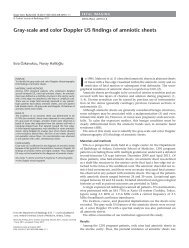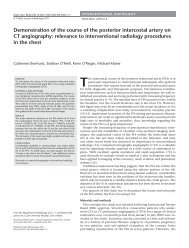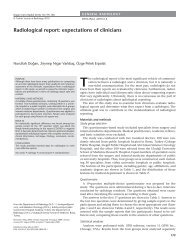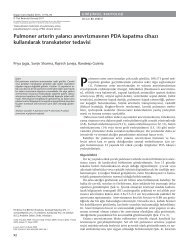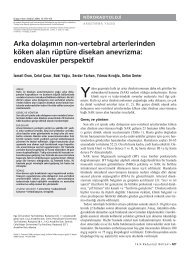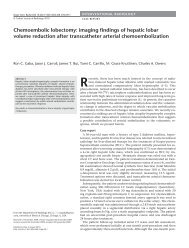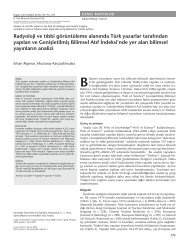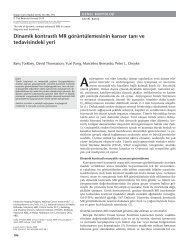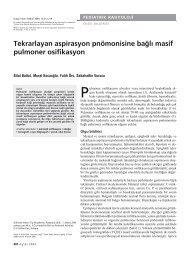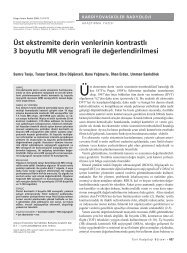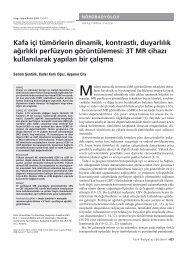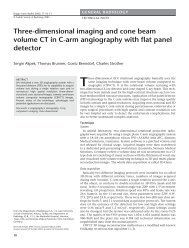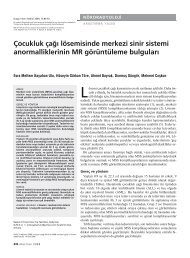Erken postoperatif beyin difüzyon aÄırlıklı MR görüntüleme ile ...
Erken postoperatif beyin difüzyon aÄırlıklı MR görüntüleme ile ...
Erken postoperatif beyin difüzyon aÄırlıklı MR görüntüleme ile ...
You also want an ePaper? Increase the reach of your titles
YUMPU automatically turns print PDFs into web optimized ePapers that Google loves.
Kaynaklar<br />
1. Cha S. Update on brain tumor imaging:<br />
from anatomy to physiology. AJNR Am J<br />
Neuroradiol 2006; 27: 475-487.<br />
2. Smith JS, Cha S, Mayo MC et al. Serial<br />
diffusion-weighted magnetic resonance<br />
imaging in cases of glioma: distinguishing<br />
tumor recurrence from postresection injury.<br />
J Neurosurg 2005; 103: 428-438.<br />
3. Bammer R. Basic principles of diffusionweighted<br />
imaging. Eur J Radiol 2003; 45:<br />
169-184.<br />
4. Moritani T, Shrier DA, Numaguchi Y, et al.<br />
Diffusion-weighted echo-planar <strong>MR</strong> imaging:<br />
clinical applications and pitfalls. A<br />
pictorial essay. Clin İmaging 2000; 24:181-<br />
192.<br />
5. Beauchamp NJ, Ulug AM, Passe TJ, et al.<br />
<strong>MR</strong> diffusion imaging in stroke: review<br />
and controversies. Radiographics 1998;<br />
18:1269-1283.<br />
6. Roley HA, Grant PE, Roberts TPL.<br />
Diffusion <strong>MR</strong> imaging. Theory and applications.<br />
Neuroimaging Clin North Am 1999;<br />
9:343-361.<br />
7. Ebisu T, Naruse S, Horikawa Y, et al.<br />
Discrimination between different types of<br />
white matter edema with diffusion-weighted<br />
<strong>MR</strong> imaging. J Magn Reson Imaging<br />
1993; 3:863-868.<br />
8. Ebisu T, Tanaka C, Umeda M, et al.<br />
Discrimination of brain abscess from<br />
necrotic or cystic tumors by diffusionweighted<br />
echo-planar <strong>MR</strong> imaging. Magn<br />
Reson Imaging 1996; 14:1113-1116.<br />
9. Tien RD, Felsberg GJ, Friedman H, et al.<br />
<strong>MR</strong> imaging of high-grade cerebral gliomas:<br />
value of diffusion-weighted echo-planar<br />
pulse sequence. AJR Am J Roentgenol<br />
1993; 162: 671-677.<br />
10. Ono J, Harada K, Mano T, et al.<br />
Differentiation of dys- and demyelination<br />
using diffusion anisotrophy. Pediatr Neurol<br />
1997; 16:63-66.<br />
11. Schaefer PW, Grant PE, Gonzalez RG.<br />
Diffusion-weighted <strong>MR</strong> Imaging of the<br />
Brain. Radiology 2000; 217:331-345.<br />
12. Huisman TAG. Diffusion-weighted imaging:<br />
basic concepts and application in cerebral<br />
stroke and head trauma. Eur Radiol<br />
2003; 13:2283-2297.<br />
13. Warach S, Chien D, Li W, et al. Fast magnetic<br />
resonance diffusion-weighted imaging<br />
of acute human stroke. Neurology 1992;<br />
42:1717-1723.<br />
14. Schlaug G, Siewert B, Benfield A, et al.<br />
Time course of the apparent diffusion coefficient<br />
(ADC) abnormality in human stroke.<br />
Neurology 1997; 49:113-119<br />
15. Chien D, Kwong KK, Gres DR, et al.<br />
<strong>MR</strong> diffusion-weighted imaging of cerebral<br />
infarction in humans. AJNR Am J<br />
Neuroradiol 1992; 13:1097-1102.<br />
16. Mintorovitch J, Yang GY, Shimizu H, et<br />
al. Diffusion-weighted magnetic resonance<br />
imaging of acute focal cerebral ischemia:<br />
comparison of signal intensity with changes<br />
in brain water and Na+, K(+)- ATPase<br />
activity. J Cereb Blood Flow Metab 1994;<br />
14:332-336.<br />
EVALUATION OF PARENCHYMAL CHANGES AT THE OPERATION SITE WITH EARLY<br />
POSTOPERATIVE BRAIN DIFFUSION-WEIGHTED MAGNETIC RESONANCE IMAGING<br />
PURPOSE<br />
To evaluate diffusion changes in the brain parenchyma at the operation site during<br />
the first 24 hours following surgery.<br />
MATERIALS AND METHODS<br />
The study group consisted of 52 patients, 39 who had tumor resection surgery and 13<br />
who had ep<strong>ile</strong>psy surgery. Early postoperative magnetic resonance imaging (<strong>MR</strong>I) included<br />
diffusion-weighted imaging (DWI) and routine contrast-enhanced cranial <strong>MR</strong>I,<br />
together with T2* weighted images on a 3T system. DWI findings and the presence of<br />
hemorrhage in the brain parenchyma were evaluated. Correlation between the findings,<br />
the primary lesion leading to surgery, and operation site were evaluated.<br />
RESULTS<br />
Diffusion restriction in the parenchyma surrounding the resection cavity was seen in 17<br />
tumor patients (32.7%, n = 52) and in 8 ep<strong>ile</strong>psy patients (15.4%, n = 52). DWI showed<br />
increased diffusion in 7 patients and no abnormality in 4 patients. Twenty patients<br />
showed restricted diffusion pattern related to hemorrhage (38.5%, n = 52).<br />
CONCLUSION<br />
Restricted diffusion was the most common abnormality observed in the early postoperative<br />
DWI of brain parenchyma at the operation site after surgery, which suggested<br />
tissue injury caused by surgery. Yet, hemorrhaging in the operation bed can constitute<br />
another cause of a reduced apparent diffusion coefficient (ADC) value. Increased<br />
diffusion and normal diffusion can also be observed, though rarely.<br />
Key words: • brain • postoperative • diffusion weighted <strong>MR</strong>I<br />
Diagn Interv Radiol 2006; 12:115-120<br />
17. Kucharczyk J, Vexler ZS, Roberts TP, et al.<br />
Echo-planar perfusion sensitive <strong>MR</strong> imaging<br />
of acute cerebral ischemia. Radiology<br />
1993; 188:711-717.<br />
18. Matsumoto K, Lo EH, Pierce AR, et al. Role<br />
of vasogenic edema and tissue cavitation in<br />
ischemic evolution on diffusion-weighted<br />
imaging: comparision with multiparameter<br />
<strong>MR</strong> and immunohistochemistry. AJNR Am<br />
J Neuroradiol 1995; 16:1107-1115.<br />
19. Atlas SW, Dubois P, Singer MB, et al.<br />
Diffusion measurements in intracranial<br />
hematomas: implications for <strong>MR</strong> imaging<br />
of acute stroke. AJNR Am J Neuroradiol<br />
2000; 29:1190-1194.<br />
20. Latour L, Svoboda K, Mitra P, et al. Timedependent<br />
diffusion of water in a biological<br />
model system. Proc Natl Acad Sci USA<br />
1994; 91:1229-1233.<br />
21. Hijiya N, Horuiuchi K, Asakura T.<br />
Morphology of sickle cells produced in<br />
solutions of varying osmolarities. J Lab<br />
Clin Med 1991; 117:60-66.<br />
22. Kaibara M. Rheology of blood coagulation.<br />
Biorheology 1996; 33:101-117.<br />
23. Hargens A, Bowie L, Lendt D, et al. Sicklecell<br />
hemoglobin: fall in osmotic pressure<br />
upon deoxygenation. Proc Natl Acad Sci<br />
USA 1980; 77: 4310-4312.<br />
24. Atlas S, Thulborn K. <strong>MR</strong> detection of<br />
hyperacute parenchymal hemorrhage of<br />
the brain. AJNR Am J Neurorad 1998;<br />
19:1471-1507.<br />
25. Kang BK, Na DG, Ryoo JW, et al. Diffusionweighted<br />
<strong>MR</strong> imaging of intracerebral hemorrhage.<br />
Korean J Radiol 2001; 2:183-191.<br />
26. Silvera S, Oppenheim C, Touze E, et al.<br />
Spontaneous intracerebral hematoma on<br />
diffusion-weighted images: influence of<br />
T2-shine-through and T2-blackout effects.<br />
AJNR Am J Neuroradiol 2005; 26:236-<br />
241.<br />
27. Sohn CH, Baik SK, Lee HJ, et al. <strong>MR</strong><br />
imaging of hyperacute subarachnoid and<br />
intraventricular hemorrhage at 3T: a preliminary<br />
report of gradient echo T2*-weighted<br />
sequences. AJNR Am J Neuroradiol 2005;<br />
26:662-665.<br />
28. Lu CY, Chiang IC, Lin WC, Kuo YT, Liu<br />
GC. Detection of intracranial hemorrhage:<br />
comparison between gradient-echo images<br />
and b0 images obtained from diffusionweighted<br />
echo-planar sequences on 3.0 T<br />
<strong>MR</strong>I. Clin Imaging 2005; 29:155-161.<br />
29. Hodozuka A, Sako K, Yonemasu Y.<br />
Sequential change of capillary permeability<br />
in the rat brain after surgical removal of an<br />
experimental brain tumor. J Neurooncol<br />
1993; 16:191-200.<br />
Türk Radyoloji Bülteni • A35



